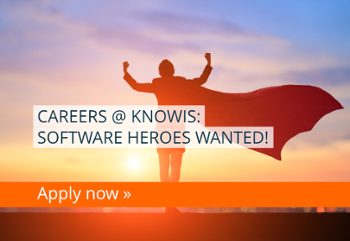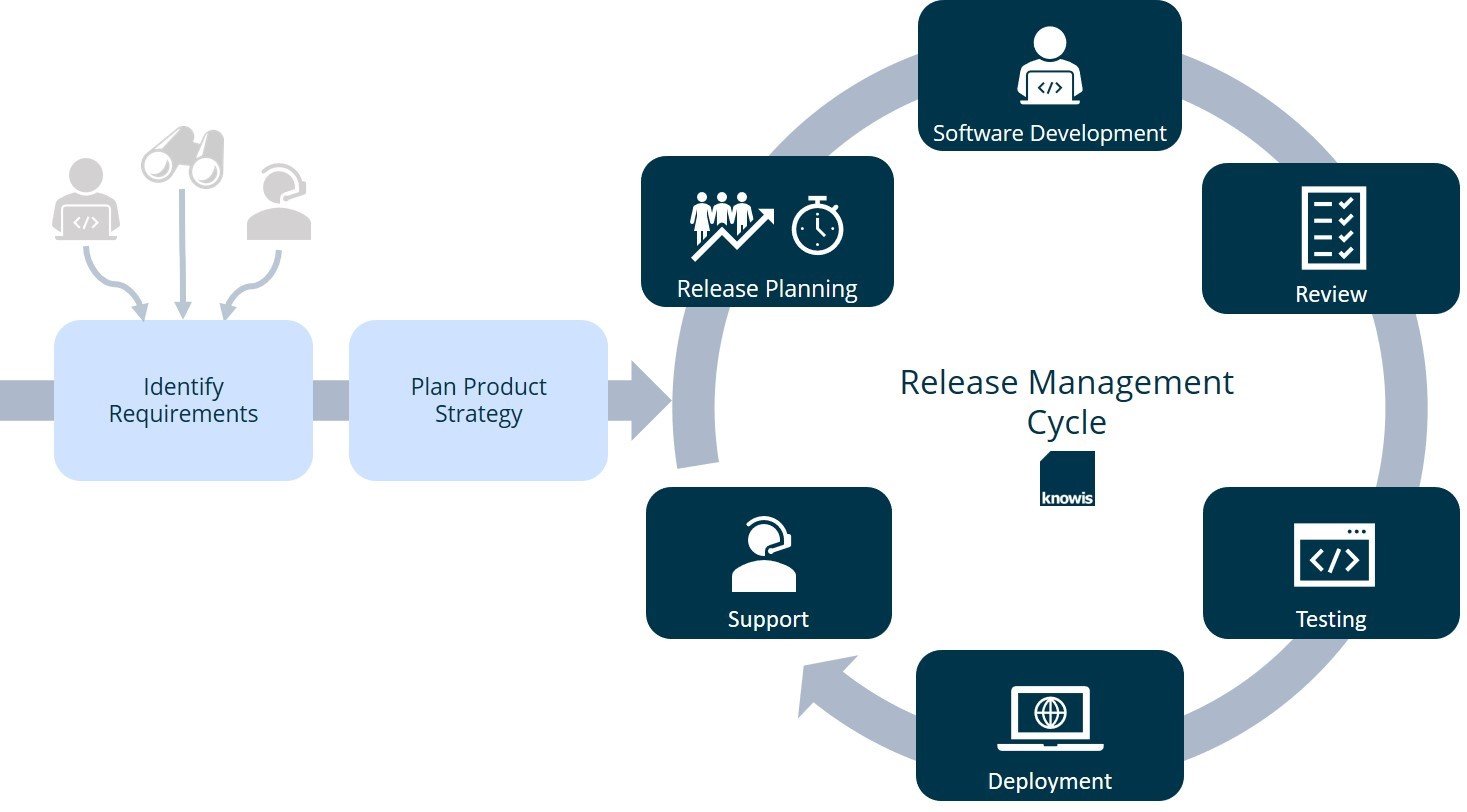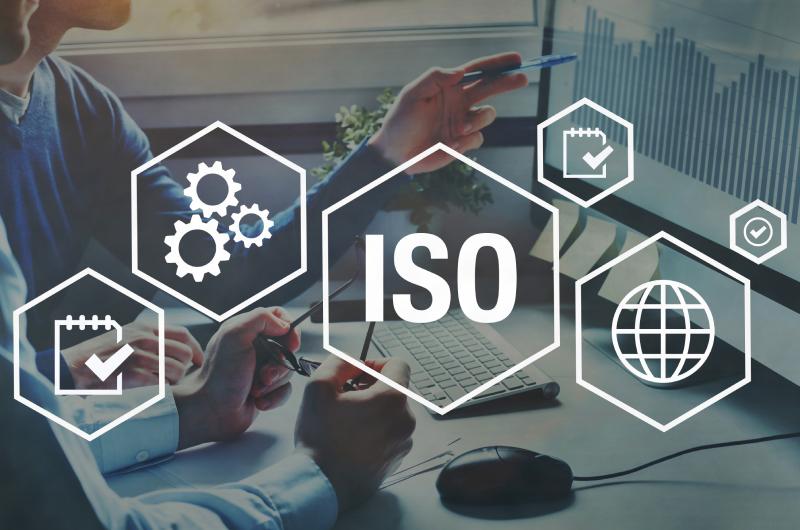
A product manager supervises the journey of a product from the first idea to the market launch. Even abstract digital products, such as software solutions, are accompanied by a product manager at all stages of their development and the subsequent product life cycle. The Regensburg-based software provider knowis is a perfect match for organizational talents with a good understanding of the customer's interests – if their heart beats for knowledge-based process platforms and cloud solutions.
What distinguishes a traditional product manager from a digital product manager who looks after web services, online stores or software? Markus Nadolski is responsible for intelligent software solutions in the financial sector at knowis AG. In the following interview, he gives exciting insights into his various fields of responsibility and explains how he guides the process of software development in his role as Product Owner of the isfinancial banking platform.
Markus, how did you come across knowis and how long have you been here?
 I have been with knowis for five years now. Previously, I worked in various banks in the lending business for many years. I therefore know from my own experience what is important to our clients, banks and financial institutions.
I have been with knowis for five years now. Previously, I worked in various banks in the lending business for many years. I therefore know from my own experience what is important to our clients, banks and financial institutions.
Because I've always been very interested in IT, at some point in my life I wanted to switch to this field as a profession. So, the question was: where do I find a job at the intersection of banking and IT? That’s how I came to knowis.
You only recently became a product manager – what did you do previously with knowis?
At the beginning of my knowis career, I worked as a business analyst. During that time, I looked after many projects while working at the customer's site. The requirements for a product manager are in some respects similar to the tasks that I worked on as a business analyst for many years. In my new position, this helps a lot to understand the big picture, for example, by knowing how the knowis banking platform is actually used and what our customers' experience has been with it. That's why switching to product management was the right step for me to continue to use my strengths and at the same time expand my knowledge.
What are your responsibilities as a product manager?
As an agile software company, we think and plan in release cycles. We want to renew and improve our software on a regular basis, so as a product manager, I deal a lot with feature requests and the enhancement of our software, as well as the prioritization of the different requirements.
New requirements come either directly from the customer or are suggested internally, for example, by our business analysts or the solution engineers. My job is to translate the often rather unspecific needs. This means I must think carefully about what is needed in particular and whether it might already be feasible in other ways. At the same time, it is always important to assess the development effort of a feature; for this part, I collaborate with an IT architect or developer.
Ultimately, I have to weigh how sensible the implementation of such a feature would be, that is to measure the business value against the development effort. Before each release, for example, we try to estimate the sensibility in a 'business poker' process, where we discuss everything in detail and view the features from different angles. If a feature is to be considered for the next release, I define criteria that must be met during development. These are compared after the implementation and verified by the testing team – so you can already see: product management at knowis is closely integrated with other departments.
What skills or special abilities should you bring as a product manager?
It is very important to develop an understanding of how our software is used. When assessing the 'value' of a feature, a product manager should be able to capture the customer's view and, based on that, prioritize the requirements, while at the same time considering the implementation effort. In addition, the constant development of the knowis software platform is an important topic that needs to be structured and clearly defined.
A basic understanding of the technologies used, and the ability to work closely and effectively with different stakeholders, are among the requirements that a Product Manager should bring to knowis.
Rock ’n’ Roll-out: The Tasks of a Product Manager
The product manager accompanies products or services from conception to successful roll-out and beyond. Versatility is an important characteristic, as he or she coordinates various business units that share responsibility for the product. This includes, for example, development, design, marketing, and sales. Project management, quality management and operations are also among his or her tasks. At the same time, the product manager should keep an eye on the competitors in the market.
However, the exact requirements and focus of the job profile depend on the industry and the role definition of the respective company: A product manager working for an IT company like knowis obviously faces different tasks than a product manager in the automotive or tourism industry. Although the basic concept of the job profile is similar, there are significant differences.
The main goal of product management at knowis is to implement suitable software solutions for customers, such as banks and financial institutions, while optimizing the long-term business value of the product. To achieve this, the isfinancial banking platform, just like the other knowis products, is regularly updated with new features and applications. The management of the entire release life cycle is therefore the focus of the work of the product manager.
What Does a Product Manager at knowis Do?
The first step is the roll-in process, the gathering of stakeholder interests. These may come from a variety of sources: They may be inspired by customers, knowis developers or support, for instance, or they may result from market observations. With so many requirements from different perspectives, it is important for the product manager to assess the importance of each requirement by evaluating them according to economic and technological criteria. This also helps him or her to find out whether a potential new feature of the software might be relevant to multiple stakeholders.
When planning the product strategy, the medium- to long-term goals for the software product are defined. A strategy that is consistent with the interests of all those involved is the basis for successful product development and a prerequisite for the planning of the releases. For these, the requests are prioritized on the basis of the product strategy, and the time and resources required are clearly defined. Only when the release planning is complete and acceptance criteria have been defined for the individual requests do the software developers start with the implementation of the objectives of product management using this framework.
After the development of the software, the product manager’s work is not yet done. Among other things, a software release also entails the preparation of documentation that contains all the important information such as system requirements (software and hardware) and the user/developer manual, as well as changes from earlier versions. The implementation plan of a release and regular quality controls by the product manager are important points of reference for all project participants – this shows the significance of product management in the overall structure of the company: It serves as the command center.
What Qualifications Do You Need to Succeed as a Product Manager?
To successfully work as a product manager in a software company that supports banks on the path of digital transformation, you need special skills and industry-specific know-how. Some experience in finance, business thinking and enthusiasm for modern technologies and software architecture are definitely beneficial.
 knowis stands for agile software development – so it is particularly important that you, as a responsible product manager, understand the complex product with all its facets. This is the only way to ensure a dynamic development process and minimize risks, such as misunderstood customer requests or incorrect planning, right from the start with your help. Having some basic programming skills, tool skills (such as JIRA) or experience in requirements engineering will help you with your job. As a software architect or developer who wants to progress, you bring the perfect qualifications.
knowis stands for agile software development – so it is particularly important that you, as a responsible product manager, understand the complex product with all its facets. This is the only way to ensure a dynamic development process and minimize risks, such as misunderstood customer requests or incorrect planning, right from the start with your help. Having some basic programming skills, tool skills (such as JIRA) or experience in requirements engineering will help you with your job. As a software architect or developer who wants to progress, you bring the perfect qualifications.
Excellent communication skills and knowledge of project and release management, for example, experience with agile methods such as Scrum and Kanban, complete your profile. Since knowis is a growing and international company, the English language should not be new territory for you. You do not necessarily have to have a degree in business administration or computer science: the most important qualities are commitment and passion – we look forward to receiving your application!
Image sources: Teaser: PeopleImages - 540567758 - iStock; Info graphics: knowis AG









